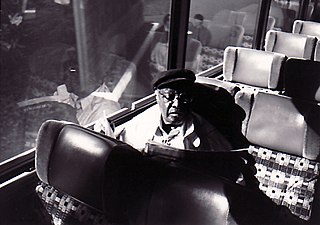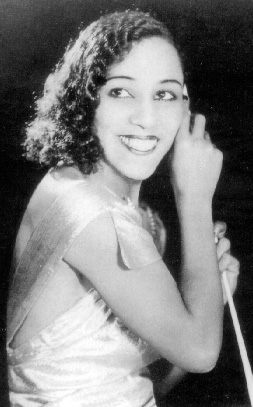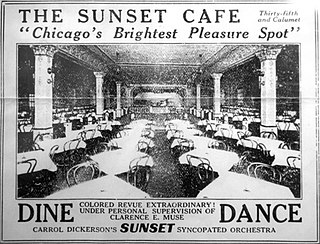Related Research Articles

John Birks "Dizzy" Gillespie was an American jazz trumpeter, bandleader, composer, educator and singer. He was a trumpet virtuoso and improviser, building on the virtuosic style of Roy Eldridge but adding layers of harmonic and rhythmic complexity previously unheard in jazz. His combination of musicianship, showmanship, and wit made him a leading popularizer of the new music called bebop. His beret and horn-rimmed spectacles, scat singing, bent horn, pouched cheeks, and light-hearted personality have made him an enduring icon.

Cabell Calloway III was an American jazz singer and bandleader. He was associated with the Cotton Club in Harlem, where he was a regular performer and became a popular vocalist of the swing era. His niche of mixing jazz and vaudeville won him acclaim during a career that spanned over 65 years.

The Mills Blue Rhythm Band was an American big band active during the 1930s.
"Minnie the Moocher" is a jazz-scat song first recorded in 1931 by Cab Calloway and His Orchestra, selling over a million copies. "Minnie the Moocher" is most famous for its nonsensical ad libbed ("scat") lyrics. In performances, Calloway would have the audience and the band members participate by repeating each scat phrase in a form of call and response, until making it too fast and complicated for the audience to replicate it.

Milton John Hinton was an American double bassist and photographer.
Leon Brown "Chu" Berry was an American jazz tenor saxophonist during the 1930s. He is perhaps best known for his time as a member of singer Cab Calloway's big band.

Blanche Dorothea Jones Calloway was an American jazz singer, composer, and bandleader. She was the older sister of Cab Calloway and was a successful singer before her brother. With a music career that spanned over fifty years, Calloway was the first woman to lead an all-male orchestra and performed alongside musicians such as Cozy Cole, Chick Webb, and her brother. Her performing style was described as flamboyant and a major influence on her brother's performance style.
Walter Purl "Foots" Thomas was an American saxophonist, flutist, and arranger in Cab Calloway's orchestra, one of the most famous bands of the swing era in jazz.
Hilton Jefferson was an American jazz alto saxophonist born in Danbury, Connecticut, United States, perhaps best known for leading the saxophone section from 1940 to 1949 in the Cab Calloway band. Jefferson is said to have been "a soft, delicate saxophone player, with an exquisite sensibility."

The Sunset Cafe, also known as The Grand Terrace Cafe, was a jazz club in Chicago, Illinois operating during the 1920s, 1930s and 1940s. It was one of the most important jazz clubs in America, especially during the period between 1917 and 1928 when Chicago became a creative capital of jazz innovation and again during the emergence of bebop in the early 1940s. From its inception, the club was a rarity as a haven from segregation, since the Sunset Cafe was an integrated or "Black and Tan" club where African Americans, along with other ethnicities, could mingle freely with white Americans without much fear of reprisal. Many important musicians developed their careers at the Sunset/Grand Terrace Cafe.

Hi De Ho is a 1947 American musical race film directed by Josh Binney. Distributed by All American Entertainment, the film stars an all African American cast, led by Cab Calloway. It first showed at the Squire Theatre in New York, and would be shown in the more than 500 African-American theaters in the US.
Cab Calloway's Hi-De-Ho is an American musical short film directed by Fred Waller and released by Paramount Pictures in 1934. The film stars jazz bandleader Cab Calloway and actress Fredi Washington. In 2001, the film was reissued by Kino International in the DVD collection Hollywood Rhythm: Vol. 1-The Best Of Jazz And Blues.
Frederic Homer Johnson, known professionally as Keg Johnson, was an American jazz trombonist.
Hi-De-Ho may refer to:
Lester Rallingston "Shad" Collins was an American jazz trumpet player, composer and arranger, who played in several leading bands between the 1930s and 1950s, including those led by Chick Webb, Benny Carter, Count Basie, Lester Young, Cab Calloway and Sam "The Man" Taylor.
Alyn Shipton is an English jazz author, presenter, critic, and jazz bassist.
Kermit "Scotty" Scott was a jazz tenor saxophonist. Dizzy Gillespie considered Scott “one of the founders of our music” [bop].
Henry "Rubberlegs" Williams was an American blues and jazz singer, dancer and occasional female impersonator. A star of Vaudeville, he is probably best remembered for his singing work with Charlie Parker and Dizzy Gillespie, although it was his dancing for which he was renowned in New York City and Boston.
The Missourians were an American jazz band active in the 1920s, who performed at the Cotton Club in New York City and eventually became the backing band for Cab Calloway.
Jasper "Jap" Allen was an American jazz musician and bandleader. He played tuba, sousaphone and bass violin.
References
- ↑ Gillespie, Dizzy (2009) To Be, Or Not... to Bop, p. 108. U of Minnesota Press At Google Books. Retrieved 18 May 2013.
- ↑ Shipton, Alyn (2010) Hi-de-ho: The Life of Cab Calloway, p. 174. Oxford University Press At Google Books. Retrieved 18 May 2013.
- ↑ Alyn Shipton (19 July 2001). Groovin' High: The Life of Dizzy Gillespie. Oxford University Press. p. 74. ISBN 9780195349382 . Retrieved 2013-01-22.
- ↑ John Murph. "Cab Calloway: 'A Hi De Ho Centennial'". NPR.org. Retrieved 2021-06-16.
- ↑ Shipton, Alyn (2010) Hi-de-ho: The Life of Cab Calloway, p. 284. Oxford University Press At Google Books. Retrieved 18 May 2013.
- ↑ Shipton, Alyn (2010) Hi-de-ho: The Life of Cab Calloway, p. 68. Oxford University Press At Google Books. Retrieved 18 May 2013.